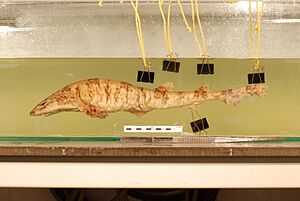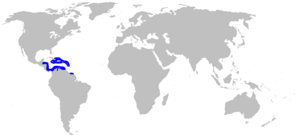Boa catshark facts for kids
Quick facts for kids Boa catshark |
|
|---|---|
 |
|
| Conservation status | |
| Scientific classification | |
| Genus: |
Scyliorhinus
|
| Species: |
boa
|
 |
|
The boa catshark (Scyliorhinus boa) is a type of catshark. It belongs to the Scyliorhinidae family, which is a group of sharks. This shark lives in the deep waters of the Caribbean Sea and the Gulf of Mexico. You can find it on the edges of the land under the sea, called continental shelves, and on underwater slopes. It usually lives at depths between 330 and 675 meters (about 1,080 to 2,215 feet). The boa catshark can grow to be about 54 centimeters (21 inches) long. It reproduces by laying eggs, which means it is an oviparous animal.
Contents
What Does the Boa Catshark Look Like?
The boa catshark is a small shark with a slim body. It can grow up to about 54 centimeters (21 inches) long. Its nose flaps don't reach its mouth. It only has grooves on its lower lip.
Fins and Skin
The first fin on its back (dorsal fin) starts just behind its belly fins. There's a big space before the second dorsal fin, which is much smaller. The skin of the boa catshark feels a little rough. This is because it's covered in tiny, tooth-like scales called placoid scales.
Colors and Patterns
The top of the boa catshark's body is a pale yellowish-brown. It has some faint grey patches and stripes. These markings are outlined with small black spots. Sometimes, other black spots form net-like patterns. You might also see a few white spots scattered on its body.
Where Does the Boa Catshark Live?
The boa catshark lives in the warm, western part of the Atlantic Ocean and the Caribbean Sea. It stays close to the seabed. You can find it on the deep edges of land under the sea, called continental shelves, and on underwater slopes. Its home stretches from about 20°N to 9°N latitude. This shark is a deep-sea creature, living at depths between 329 and 676 meters (about 1,080 to 2,218 feet).
How Does the Boa Catshark Live?
Scientists haven't studied the boa catshark very much. We know that it is an oviparous species. This means the female shark lays eggs. She usually lays them in pairs. The young sharks grow inside these eggs, getting their food from a yolk sac.
Is the Boa Catshark in Danger?
The boa catshark lives in very deep water. This is good news for the shark! It means it lives below where most fishing boats use their nets. Because of this, the boa catshark doesn't seem to be facing many threats. The International Union for Conservation of Nature (IUCN) has looked at its situation. They have decided that its conservation status is "least concern". This means it's not currently in danger of disappearing.


